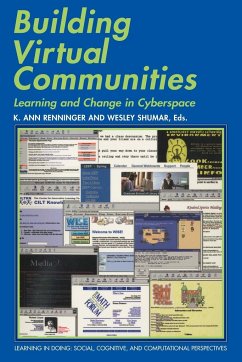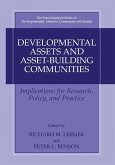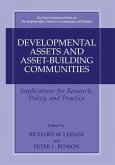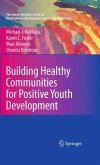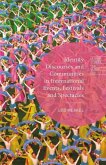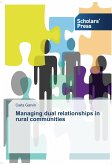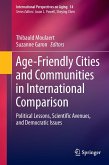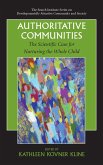Building Virtual Communities examines how learning and cognitive change are fostered by online communities. Contributors to this volume explore this question by drawing on their different theoretical backgrounds, methodologies, and personal experience with virtual communities. Each chapter discusses the different meanings of the terms community, learning, and change. Case studies are included for further clarification. Together, these chapters describe the building out of virtual communities in terms that are relevant to theorists, researchers, and practitioners. The chapters provide a basis for thinking about the dynamics of Internet community building. This includes consideration of the role of the self or individual as a participant in virtual community, and the design and refinement of technology as the conduit for extending and enhancing the possibilities of community building in cyberspace. Building Virtual Communities will interest educators, psychologists, sociologists, and researchers in human-computer interaction.
Table of contents:
Preface K. Ann Renninger and Wesley Shumar; Foreword: virtual communities for learning and development: a look to the past and some glimpses into the future Michael Cole; Introduction: on conceptualizing community Wesley Shumar and K. Ann Renninger; Part I. Types of Community: 1. The mystery of the death of Mediamoo: seven years of evolution of an online community Amy Bruckman and Carlos Jensen; 2. Female voices in virtual reality: drawing young girls into an on-line world Ann Locke Davidson and Janet Ward Shofield; 3. Community building with and for teachers at the math forum K. Ann Renninger and Wesley Shumar; 4. Learning in the virtual community depends upon changes in local communities Beverly Hunter; Part II. Structure and Community: 5. Evolution of an on-line education community of practice Mark S. Schlager, Judith Fusco and Patricia Schank; 6. Building social networks via computer networks: creating and sustaining distributed learning communities Caroline Haythornthwaite; 7. Mask and identity: the hermeneutics of self construction in the information age Dorian Wiszniewski and Richard Coyne; 8. WISE learning communities: design considerations Alex J. Cuthbert, Douglas B. Clark and Marcia C. Linn; Part III. Possibilities for Community: 9. Reflexive modernization and the emergence of wired self-help Roger Burrows and Sarah Nettleton; 10. Understanding the lifecycles of network-based learning communities James Levin and Raoul Cervantes; 11. Learning in cyberspace: an educational view of virtual community D. Jason Nolan and Joel Weiss; 12. Finding the ties that bind: tools in support of a knowledge-building community Christopher M. Hoadley and Roy D. Pea; Afterword: building our knowledge of virtual community: some responses David Hakken; Afterword: building, buying, or being there: imagining online community Steven G. Jones.
Building Virtual Communities examines how learning and cognitive change are fostered by online communities. Contributors to this volume explore this question by drawing on their different theoretical backgrounds, methodologies, and personal experience with virtual communities. This book will interest educators, psychologists, sociologists, and researchers in human- computer interaction.
Building Virtual Communities examines how learning and cognitive change are fostered by online communities.
Hinweis: Dieser Artikel kann nur an eine deutsche Lieferadresse ausgeliefert werden.
Table of contents:
Preface K. Ann Renninger and Wesley Shumar; Foreword: virtual communities for learning and development: a look to the past and some glimpses into the future Michael Cole; Introduction: on conceptualizing community Wesley Shumar and K. Ann Renninger; Part I. Types of Community: 1. The mystery of the death of Mediamoo: seven years of evolution of an online community Amy Bruckman and Carlos Jensen; 2. Female voices in virtual reality: drawing young girls into an on-line world Ann Locke Davidson and Janet Ward Shofield; 3. Community building with and for teachers at the math forum K. Ann Renninger and Wesley Shumar; 4. Learning in the virtual community depends upon changes in local communities Beverly Hunter; Part II. Structure and Community: 5. Evolution of an on-line education community of practice Mark S. Schlager, Judith Fusco and Patricia Schank; 6. Building social networks via computer networks: creating and sustaining distributed learning communities Caroline Haythornthwaite; 7. Mask and identity: the hermeneutics of self construction in the information age Dorian Wiszniewski and Richard Coyne; 8. WISE learning communities: design considerations Alex J. Cuthbert, Douglas B. Clark and Marcia C. Linn; Part III. Possibilities for Community: 9. Reflexive modernization and the emergence of wired self-help Roger Burrows and Sarah Nettleton; 10. Understanding the lifecycles of network-based learning communities James Levin and Raoul Cervantes; 11. Learning in cyberspace: an educational view of virtual community D. Jason Nolan and Joel Weiss; 12. Finding the ties that bind: tools in support of a knowledge-building community Christopher M. Hoadley and Roy D. Pea; Afterword: building our knowledge of virtual community: some responses David Hakken; Afterword: building, buying, or being there: imagining online community Steven G. Jones.
Building Virtual Communities examines how learning and cognitive change are fostered by online communities. Contributors to this volume explore this question by drawing on their different theoretical backgrounds, methodologies, and personal experience with virtual communities. This book will interest educators, psychologists, sociologists, and researchers in human- computer interaction.
Building Virtual Communities examines how learning and cognitive change are fostered by online communities.
Hinweis: Dieser Artikel kann nur an eine deutsche Lieferadresse ausgeliefert werden.

